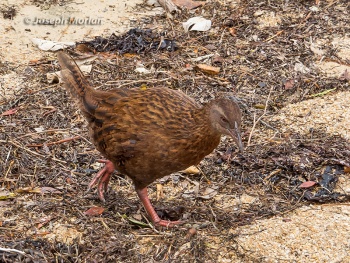- Gallirallus australis
Identification
Male 50–60cm (19¾-23½ in); Female 46–50cm (18-19¾ in). 700-1000gms (1.5-2.2lbs). Sturdy, short bill and legs. Walks quietly and flicks leaves in order to look for food. Plumage is brown, streaked with black, but varies on subspecies.
Variations
Nominate australis has chestnut plumage except in Fiordland, where a morph form is common. G. a. greyi is rare and is greyer below with brown legs, hectori is the palest in colour, and scotti is the smallest and also has a chestnut, gray and dark morphs, but averages paler than australis.
Distribution
A locally common, flightless New Zealand endemic. Northeast corner of North Island, plus the sanctuaries of Kapiti and Tiritiri Matangi Islands; South Island - northwest corner and Fiordland in the southwest, plus Stewart and Chatham Islands, with some other isolated areas on the west coast.
Taxonomy

Photo © by Joseph Morlan
Rakiura NP-Ulva Island, Southland District, New Zealand, 3 January 2017
Subspecies
There are 4 subspecies[1]:
- G. a. greyi - North Island (New Zealand)
- G. a. australis - Western region of South Island (New Zealand)
- G. a. hectori - Formerly South Island (New Zealand); introduced Chatham Islands
- G. a. scotti - Stewart, Solander and Codfish Islands (off New Zealand)
Habitat
Forest, scrub as well as open country, so long as there is good cover available.
Behaviour
May be very inquisitive. Can run fast with neck outstretched.
Breeding
Breeding: August-February, actual timing depends on the availability of food and weather conditions.
Vocalisation
Has a loud repeated territorial call - 'coo-eet', rising in pitch.
References
- Clements, J. F., T. S. Schulenberg, M. J. Iliff, D. Roberson, T. A. Fredericks, B. L. Sullivan, and C. L. Wood. 2018. The eBird/Clements checklist of birds of the world: v2018. Downloaded from http://www.birds.cornell.edu/clementschecklist/download/
- Taylor, B. & Sharpe, C.J. (2017). Weka (Gallirallus australis). In: del Hoyo, J., Elliott, A., Sargatal, J., Christie, D.A. & de Juana, E. (eds.). Handbook of the Birds of the World Alive. Lynx Edicions, Barcelona. (retrieved from http://www.hbw.com/node/53608 on 8 February 2017).
- BirdForum Member observations
- Beauchamp, A.J.; Miskelly, C.M. 2013. Weka. In Miskelly, C.M. (ed.) New Zealand Birds Online. http://www.nzbirdsonline.org.nz
- BirdLife International. 2016. Gallirallus australis. The IUCN Red List of Threatened Species 2016: e.T22692384A93351412. http://dx.doi.org/10.2305/IUCN.UK.2016-3.RLTS.T22692384A93351412.en. Downloaded on 08 February 2017.
- Marchant, S. & Higgins, P.J. (editors) 1993. Handbook of Australian , New Zealand & Antarctic Birds. Volume 2, Raptors to lapwings. Melbourne, Oxford University Press. Pages 469, 486-488, 506-520; plate 41.
Recommended Citation
- BirdForum Opus contributors. (2025) Weka. In: BirdForum, the forum for wild birds and birding. Retrieved 26 April 2025 from https://www.birdforum.net/opus/Weka
External Links
GSearch checked for 2020 platform.1





